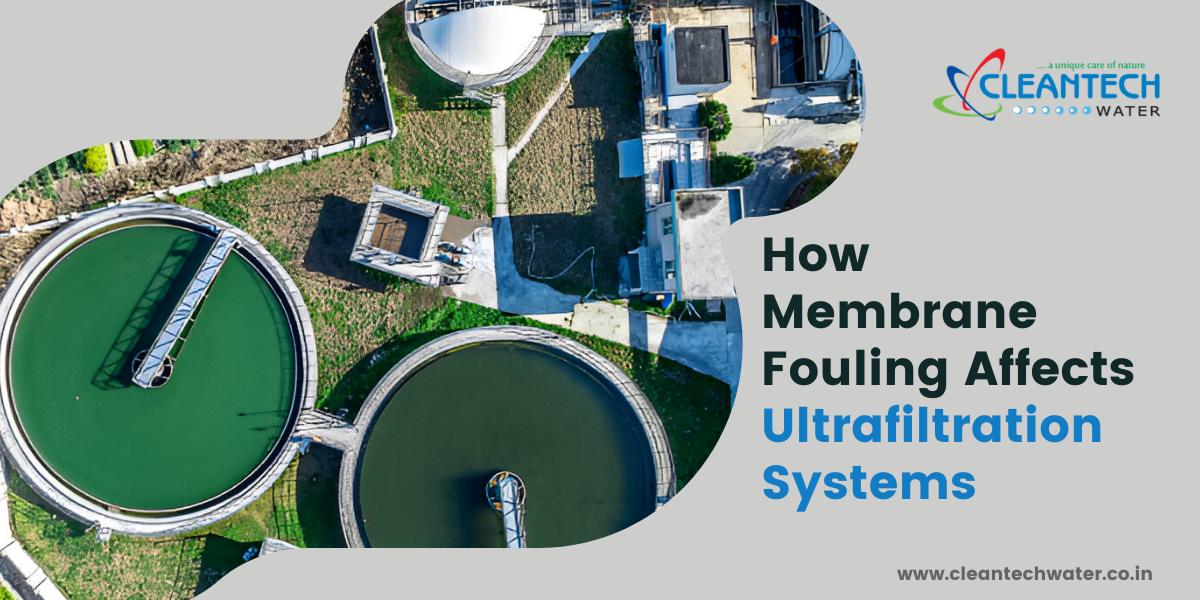Ultrafiltration systems are vital for the effective treatment of wastewater, ensuring high-quality effluent and operational efficiency in treatment plants. Despite their advantages, these systems are vulnerable to membrane fouling, where unwanted materials accumulate on the membrane surface. This fouling can significantly impair system performance, leading to reduced filtration efficiency and increased operational costs. To mitigate these issues and maintain optimal performance, it’s crucial to understand the different types of fouling and their impact on ultrafiltration systems. Effective management strategies can help minimise fouling, reduce maintenance needs, and enhance the overall efficiency of wastewater treatment plants.

Types of Membrane Fouling
Organic Fouling
Organic fouling is a common issue in ultrafiltration systems, particularly in sewage treatment plants dealing with high concentrations of organic matter. This type of fouling occurs when organic compounds, such as proteins, fats, and oils, adhere to the membrane surface. The accumulation of these substances can significantly reduce the permeability of the membrane, leading to higher transmembrane pressure and lower overall efficiency. Regular cleaning and pretreatment processes are essential to minimise organic fouling and maintain the optimal performance of the system.
Inorganic Fouling
Inorganic fouling or scaling, is caused by the deposition of inorganic salts and minerals on the membrane surface. Common culprits include calcium carbonate, calcium sulfate, and silica, which are often present in the feedwater of wastewater treatment plants. Scaling can lead to severe blockages within the membrane pores, drastically reducing water flow and filtration efficiency. Addressing inorganic fouling typically involves the use of chemical antiscalants or acid cleaning to dissolve the mineral deposits and restore the membrane’s performance.
Biofouling
Biofouling is a particularly troublesome form of fouling in wastewater treatment plants, as it involves the growth of microbial colonies on the membrane surface. Bacteria, algae, and fungi can form biofilms, which not only block the membrane but also create a slimy layer that is difficult to remove. Biofouling can lead to a rapid decline in ultrafiltration efficiency, requiring frequent cleaning cycles and potentially causing irreversible damage to the membrane. Preventative measures, such as the use of biocides and maintaining proper sanitation, are key to managing biofouling in ultrafiltration systems.
Particulate/Silt Fouling
Particulate or silt fouling occurs when suspended solids, such as clay, sand, or other fine particles, accumulate on the membrane surface. This type of fouling is particularly prevalent in sewage treatment plants where the feedwater contains high levels of turbidity. As these particles build up, they create a physical barrier that obstructs water flow, leading to increased pressure drop across the membrane. Effective pretreatment methods, such as sedimentation or the use of prefilters, are essential to reduce particulate fouling and ensure the smooth operation of the ultrafiltration systems.
Mechanisms of Membrane Fouling
Membrane fouling in ultrafiltration systems is a significant challenge for businesses operating wastewater treatment plants. Understanding the mechanisms behind fouling is essential for maintaining the efficiency and longevity of these systems.
Adsorption:
Adsorption occurs when organic and inorganic substances, such as oils, fats, proteins, and metal ions, adhere to the membrane surface. This process can drastically reduce the permeability of the membrane, as these substances form a thin layer that obstructs water flow. Over time, the buildup from adsorption leads to decreased filtration efficiency, requiring more frequent cleaning and maintenance.
Pore Blocking:
Pore blocking happens when particles, often from suspended solids in wastewater, become lodged within the pores of the membrane. This blockage reduces the flow rate and increases transmembrane pressure (TMP), making the ultrafiltration system work harder to achieve the desired filtration. Over the long term, pore blocking can lead to permanent damage, diminishing the overall effectiveness of the plant.
Cake Layer Formation:
As particles accumulate on the membrane, they can form a dense layer known as a cake layer. This layer further increases TMP and energy consumption, as the system must overcome this additional resistance to maintain filtration. Cake layer formation is a key factor in reduced ultrafiltration efficiency, leading to higher operational costs and more frequent membrane replacement.
Factors Influencing Membrane Fouling
Membrane fouling in ultrafiltration systems is influenced by various factors, each playing a crucial role in the efficiency and lifespan of sewage treatment plants.
Feed Water Quality:
The quality of feed water directly impacts the extent of membrane fouling. High levels of suspended solids, organic content, and microorganisms can accelerate fouling by increasing the deposition of particles and biofilms on the membrane surface. In particular, water with high turbidity or biological activity can lead to faster formation of foulants. This reduces the system’s filtration efficiency and increases the need for frequent maintenance.
Membrane Material and Structure:
The choice of membrane material and its structural properties are significant determinants of fouling behavior. Hydrophilic membranes, which attract water, are generally less prone to fouling compared to hydrophobic ones, which repel water. Additionally, the pore size and surface roughness of the membrane influence fouling. Smaller pore sizes can trap more particles, leading to quicker blockage, while smoother surfaces tend to resist fouling better than rougher ones.
Operational Conditions:
Operational conditions such as temperature, pressure, and flow rate also affect membrane fouling. Higher temperatures can increase fouling by altering the viscosity and solubility of contaminants. Pressure and flow rate directly influence the rate at which foulants are deposited on the membrane. Moreover, the frequency and method of cleaning play a critical role in managing fouling. Inadequate cleaning can lead to irreversible membrane damage over time.
Get a Custom Solution Now!
Consequences of Membrane Fouling on Ultrafiltration Efficiency
Membrane fouling has serious consequences for the efficiency of ultrafiltration systems in sewage treatment plants. These impacts affect system performance and lead to increased operational costs.
Reduced Permeate Flux:
Fouling significantly reduces permeate flux, or the flow rate of water through the membrane. As foulants accumulate on the membrane surface or within its pores, the resistance to water flow increases, leading to a sharp decline in filtration efficiency. This reduction in permeate flux means that the ultrafiltration system must operate longer to process the same volume of water. resulting in higher operational costs and decreased overall productivity.
Increased Energy Consumption:
As membrane fouling worsens, the system must overcome greater resistance, leading to an increase in transmembrane pressure (TMP). This higher TMP requires more energy to maintain the desired flow rate, driving up energy consumption. The economic implications are significant, as businesses operating wastewater treatment plants may face substantial increases in energy bills, which can impact their bottom line.
Membrane Damage and Shortened Lifespan:
Persistent fouling can lead to irreversible membrane damage, including deformation, pore blockage, and chemical degradation. Over time, this damage shortens the membrane’s lifespan, necessitating more frequent replacements. The costs associated with frequent membrane replacement, combined with the downtime required for installation, can be substantial. This makes effective fouling management critical for long-term operational sustainability.
Fouling Mitigation Strategies:
Effective management of membrane fouling is essential for optimising the performance of ultrafiltration systems in wastewater and sewage treatment plants. Several strategies can be employed to mitigate fouling and enhance system efficiency.
Pretreatment of Feed Water:
Pretreatment is a crucial step in fouling mitigation. It involves processes like coagulation, flocculation, and sedimentation to remove contaminants before they reach the ultrafiltration system. Coagulation adds chemicals to destabilise suspended particles, which then clump together during flocculation. These flocs are subsequently removed through sedimentation, reducing the load on the membrane. By decreasing the concentration of suspended solids, organic matter, and microorganisms in the feed water, pretreatment lowers the fouling potential. This results in improved membrane performance and extended intervals between cleanings, ultimately reducing operational costs and prolonging membrane life.
Membrane Material Innovation:
Advances in membrane technology are vital for addressing fouling challenges. Researchers are developing fouling-resistant membranes with enhanced properties. For example, hydrophilic membranes attract water, which helps prevent the adhesion of foulants. Surface modifications, such as coatings with antifouling agents or nanomaterial-infused layers, can also reduce fouling. These innovations help maintain higher permeate flux and reduce the frequency of maintenance. Membrane materials with improved resistance to fouling contribute to more efficient operation and lower long-term costs.
Cleaning and Maintenance Practices:
Regular cleaning and maintenance are essential for managing fouling. Chemical cleaning methods include using acidic, alkaline, or enzymatic solutions. Acidic cleaners dissolve inorganic scales, while alkaline cleaners address organic fouling. Enzymatic cleaners target specific organic substances for a more tailored approach. Physical cleaning techniques, such as backwashing and air scouring, are also used. Backwashing reverses water flow to remove debris, while air scouring introduces bubbles to agitate the membrane surface. Optimising cleaning schedules based on real-time data ensures cleaning is effective without causing unnecessary wear on the membrane.
Advanced Monitoring and Control:
Modern monitoring and control technologies for ultrafiltration systems offer significant advantages in managing fouling. Real-time monitoring systems track key indicators like transmembrane pressure (TMP), permeate flux, and water quality parameters. This data helps detect fouling early and allows for timely adjustments. Advanced control systems utilise machine learning and artificial intelligence (AI) to predict fouling trends and optimise maintenance schedules. By analysing historical data and identifying patterns, AI-driven systems can forecast potential fouling events. This enables preemptive measures that improve system reliability and reduce unexpected downtime.
Frequently Asked Questions
1. What are the early signs of membrane fouling in an ultrafiltration system?
Early signs of membrane fouling include a noticeable decrease in permeate flux and a rise in transmembrane pressure (TMP). Operators may also observe increased energy consumption and a more frequent need for cleaning. Monitoring these parameters regularly can help identify fouling before it leads to significant performance issues.
2. How can businesses reduce the cost of membrane replacement due to fouling?
To reduce the cost of membrane replacement, businesses should implement effective pretreatment processes to minimise fouling. Investing in high-quality, fouling-resistant membranes and optimising cleaning schedules can also extend membrane lifespan. Regular maintenance and monitoring can help detect issues early, reducing the frequency of replacements.
3. What role does feed water temperature play in membrane fouling?
Feed water temperature can significantly influence membrane fouling. Higher temperatures can increase the solubility of contaminants, leading to greater fouling rates and scaling. Conversely, lower temperatures might lead to increased viscosity and slower filtration. Maintaining optimal feed water temperature is crucial for minimising fouling and ensuring efficient operation.
4. Are there any emerging technologies that help in fouling control?
Yes, emerging technologies such as advanced membrane coatings and nanomaterial-infused membranes are being developed to combat fouling. Additionally, machine learning and AI-driven predictive maintenance tools are becoming increasingly effective in forecasting fouling trends and optimising cleaning schedules, further improving system efficiency.
5. How often should an ultrafiltration system be cleaned to prevent fouling?
The frequency of cleaning depends on factors like feed water quality, operating conditions, and the type of fouling. Generally, cleaning schedules should be optimised based on real-time monitoring data. Ultrafiltration systems with high fouling potential may require more frequent cleaning, while well-maintained systems can extend intervals between cleanings.
6. What is the impact of chemical cleaning on membrane integrity?
Chemical cleaning can be effective in removing fouling but may affect membrane integrity if not done correctly. Overuse or incorrect chemical concentrations can lead to membrane degradation or damage. It’s essential to use the appropriate chemical type and concentration and follow recommended cleaning procedures to maintain membrane health and performance.
Upgrade Your Ultrafiltration System for Superior Performance!
At Cleantech Water, we engineer and design ultrafiltration systems with unparalleled efficiency and reliability for your wastewater treatment needs. With a modular design for quick installation and a highly energy-efficient operation, our systems deliver top-notch separation performance and exceptional water quality. The long-lasting membranes are engineered to minimize fouling, reducing maintenance needs and ensuring continuous operation.
In addition, our systems come equipped with advanced monitoring and control features, giving you real-time insights for optimal performance. Built with top-class standardized equipment, you can trust our ultrafiltration solutions to provide durable, low-maintenance performance that outperforms the competition.
Contact us today at +91-9558996411 or write to us at Info@cleantechwater.co.in to learn how our ultrafiltration systems can transform your wastewater treatment plant. We will be happy to assist you in achieving optimum results for your plants.

